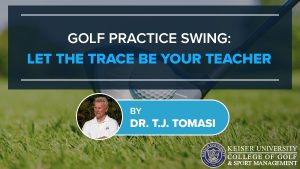Golf Practice Swing: Let the Trace be Your Teacher

by Dr. T. J. Tomasi, Keiser University College of Golf Senior Faculty and Director of Research
The practice swing is free, and if done correctly, it gives you two advantages: (1) it’s an instant pre-play — a pre-swing mulligan, and (2) it gives you a perfect prompt for your actual swing.
Golf Practice Swing
Located throughout your body are tiny sensors that report to your brain what is going on in their district — what the joints are doing, what’s happening to the stretch receptors in the muscles, how much force is being applied as you hold your golf posture, etc.
And for a brief time after you make a movement, its trace, in the form of electrical impulses, lingers in your sense memory.
Swing a weighted club and it leaves a trace in your sensory tracking system that makes your driver feel incredibly light.
Likewise, a perfect practice swing leaves a trace that will remain long enough to cue up your real swing.
The key is to let the trace be the teacher.
Please note that I used the word ‘perfect’ to amplify the concept of the practice swing.
Importance of Practice Swing in Golf
To extract maximum benefit from your rehearsal, the practice swing must be an exact replica of the swing you are about to make, and you must acknowledge its power to control your actual swing – via your acknowledgement you make a total commitment to replicating your rehearsal swing.
Most poor golfers fail to execute either the physical or mental rehearsal correctly.
Better golfers often perform the physical practice swing correctly, but without the mental commitment.
The best golfers most often perform them both correctly, and so the full power of the trace as teacher is available to them on every shot.
Science has shown that those who follow the guidance of the trace use the same muscles groups in the same sequence as used for the actual swing, which is why I call the rehearsal swing an instant pre-play.
Muscle contraction is initiated by an electrical code that comes from an action model the brain has chosen to solve the Point A to Point B problem you are about to solve.
Using the trace, you have already solved the problem – now all you have to do is do it again.
Three Elements of a Perfect Trace Rehearsal
First, always take the same number of rehearsal swings for every shot.
Doing the same thing each time is what makes a routine, routine.
Second, images cue motor responses, so fill your brain with the image of your shot by rehearsing your swing exactly as you see it in your mind.
Third, be certain that you rehearse using the same swing speed and tempo you need to send the ball to the target.
Takeaway: Don’t waste a practice swing by making a motion that doesn’t track exactly what you are about to do.
If you enjoyed this golf tip, here’s how you can get even more. Contact Keiser University College of Golf to learn more about golf careers.














